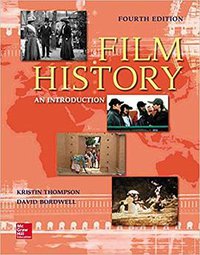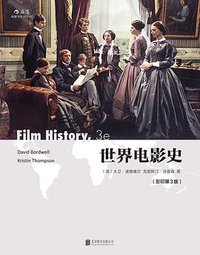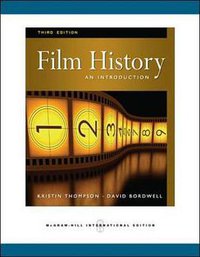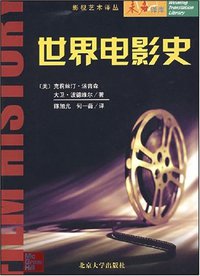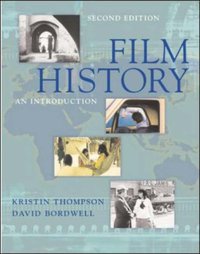Film History
豆瓣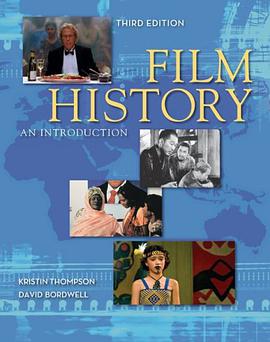
An Introduction
Kristin Thompson / David Bordwell
简介
Written by two of the leading scholars in film studies, Film History: An Introduction is a comprehensive, global survey of the medium that covers the development of every genre in film, from drama and comedy to documentary and experimental. As with the authors' bestselling Film Art: An Introduction (now in its eighth edition), concepts and events are illustrated with frame enlargements taken from the original sources, giving students more realistic points of reference than competing books that rely on publicity stills.
The third edition of Film History is thoroughly updated and includes the first comprehensive overviews of the impact of globalization and digital technology on the cinema. Any serious film scholar--professor, undergraduate, or graduate student--will want to read and keep Film History.
New Features
New final chapter, "Digital Technology and the Cinema," pulls together a wealth of recent research exploring the impact of new technology on film production, distribution, and publicity.
Revised organization splits the coverage of Latin America, the Asia-Pacific region, the Middle East, and Africa into two chapters, making the coverage of contemporary cinema in these regions more manageable.
More than 200 new film frames illustrate examples and concepts in the text providing students with more realistic points of reference, ensuring that what readers study on the page actually appears on the screen.
Updated examples and coverage throughout--particularly in Chapter 25 through 27--bring the text up to the present.
The authors' blog, Observations on film art and Film Art, includes a new essay on "Doing Film History" as well as weekly commentary on film from David Bordwell and Kristin Thompson. Visit: http://www.davidbordwell.net/blog/
contents
Preface
Introduction: Film History and How It Is Done
Why Do We Care About Old Movies?
What do Film Historians Do?
Our Approach to Film History
History as Story
Part One: Early Cinema
1 The Invention and Early Years of the Cinema, 1880s-1904
The Invention of the Cinema
Early Filmmaking and Exhibition
2 The International Expansion of the Cinema, 1905-1912
Film Production in Europe
The Struggle for the Expanding American Film Industry
The Problem of Narrative Clarity
3 National Cinemas, Hollywood Classicism and World War I, 1913-1919
The American Takeover of World Markets
The Rise of National Cinemas
The Classical Hollywood Cinema
Small Producing Countries
Part Two: The Late Silent Era, 1919-1929
4 France in the 1920s
The French Film Industry after World War I
Major Postwar Genres
The French Impressionist Movement
The End of French Impressionism
5 Germany in the 1920s
The German Situation after World War I
Genres and Styles of German Postwar Cinema
Major Changes in the Mid- to Late 1920s
The End of the Expressionist Movement
New Objectivity
Export and Classical Style
6 Soviet Cinema in the 1920s
The Hardships of War Communism, 1918-1920
Recovery under the New Economic Policy, 1921-1924
Increased State Control and the Montage Movement, 1925-1930
Other Soviet Films
The Five-Year Plan and the End of the Montage Movement
7 The Late Silent Era in Hollywood, 1920-1928
Theater Chains and the Structure of the Industry
The Motion Picture Producers and Distributors of America
Studio Filmmaking
Films for African-American Audiences
The Animated Part of the Program
8 International Trends of the 1920s
"Film Europe"
The "International Style"
Film Experiments Outside the Mainstream Industry
Documentary Features Gain Prominence
Commercial Filmmaking Internationally
Part Three: The Development of Sound Cinema, 1926-1945
9 The Introduction of Sound
Sound in the United States
Germany Challenges Hollywood
The USSR Pursues Its Own Path to Sound
The International Adoption of Sound
10 The Hollywood Studio System, 1930-1945
The New Structure of the Film Industry
Exhibition Practice in the 1930s
Continued Innovation in Hollywood
Major Directors
Genre Innovations and Transformations
Animation and the Studio System
11 Other Studio Systems
Quota Quickies and Wartime Pressures: The British Studios
Innovation within an Industry: The Studio System of Japan
India: An Industry Built on Music
China: Filmmaking Caught between Left and Right
12 Cinema and the State: The USSR, Germany, and Italy, 1930-1945
The Soviet Union: Socialist Realism and World War II
The German Cinema under the Nazis
Italy: Propaganda versus Entertainment
13 France: Poetic Realism, the Popular Front and the Occupation, 1930-1945
The Industry and Filmmaking during the 1930s
Poetic Realism
Brief Interlude: The Popular Front
Filmmaking in Occupied and Vichy France
14 Leftist, Documentary, and Experimental Cinema, 1930-1945
The Spread of Political Cinema
Government- and Corporate-sponsored Documentaries
Wartime Documentaries
The International Experimental Cinema
Part Four: The Postwar Era, 1946-1960s
15 American Cinema in the Postwar Era, 1946-1960
1946/1947/1948
The Decline of the Hollywood Studio System
The New Power of the Individual Film
The Rise of the Independents
Classical Hollywood Filmmaking: A Continuing Tradition
Major Directors: Several Generations
16 Postwar European Cinema: Neorealism and its Context, 1945-1959
The Postwar Context
Film Industries and Film Culture
Italy: Neorealism and After
A Spanish Neorealism?
17 Postwar European Cinema: France, Scandinavia, and Britain, 1945-1959
French Cinema of the Postwar Decade
Scandinavian Revival
England: Quality and Comedy
18 Postwar Cinema Beyond the West, 1945-1959
General Tendencies
Japan
Postwar Cinema in the Soviet Sphere of Influence
People's Republic of China
India
Latin America
19 Art Cinema and the Idea of Authorship
The Rise and Spread of the Auteur Theory
Authorship and the Growth of the Art Cinema
Luis Buñuel (1900-1983)
Ingmar Bergman (1918- )
Akira Kurosawa (1910-1998)
Federico Fellini (1920-1993)
Michelangelo Antonioni (1912- )
Robert Bresson (1907-1999)
Jacques Tati (1908-1982)
Satyajit Ray (1921-1992)
20 New Waves and Young Cinema, 1958-1967
The Industries' New Needs
Formal and Stylistic Trends
France: New Wave and New Cinema
Italy: Young Cinema and Spaghetti Westerns
Great Britain: "Kitchen Sink" Cinema
Young German Film
New Cinema in the USSR and Eastern Europe
The Japanese New Wave
Brazil: Cinema Nôvo
21 Documentary and Experimental Cinema in the Postwar Era, 1945-Mid-1960s
Toward the Personal Documentary
Direct Cinema
Experimental and Avant-garde Cinema
Part Five: The Contemporary Cinema Since the 1960s
22 Hollywood's Fall and Rise, 1960-1980
1960s: The Film Industry in Recession
The New Hollywood: Late 1960s-Late 1970s
Opportunities for Independents
23 Politically Critical Cinema of the 1960s and 1970s
Political Filmmaking in the Third World
Political Filmmaking in the First and Second Worlds
24 Documentary and Experimental Film Since the Late 1960s
Documentary Cinema
From Structuralism to Pluralism in Avant-garde Cinema
25 New Cinemas and New Developments: Europe and the USSR Since the 1970s
Western Europe
Eastern Europe and the USSR
26 A Developing World: Continental and Subcontinental Cinemas since 1970 New Cinemas, New Audiences
African Cinema
Filmmaking in the Middle East
South America and Mexico: Interrupted Reforms and Partnerships with Hollywood Brazil
India: Mass Output and Art Cinema
27 Cinema Rising: Pacific Asia and Oceania since 1970
Australia and New Zealand
Japan
chinese mainland
New Cinemas in East Asia
Part Six: Cinema in the Age of New Media
28 American Cinema and the Entertainment Economy: The 1980s and After
Hollywood, Cable Television, and Home Video
Concentration and Consolidation in the Film Industry
Artistic Trends
A New Age of Independent Cinema
29 Toward a Global Film Culture
Hollyworld?
Regional Alliances and the New International Film
Diasporic Cinema
The Festival Circuit
Video Piracy: An Alternative Distribution System
Fan Subcultures: Appropriating the Movies
30 Digital Technology and the Cinema
Digital Tools for Filmmaking
Distribution and Exhibition
New Media, Film, and Digital Convergence
